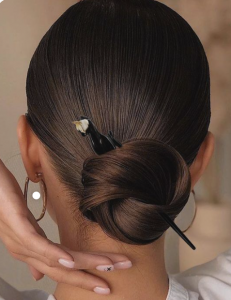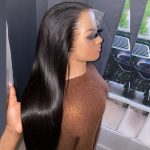Wearing a wig for the first time can be a transformative experience, whether you’re looking to change up your hairstyle, add volume, or conceal hair loss. The versatility of wigs allows you to experiment with various looks without the commitment of a permanent change. However, to ensure your wig looks natural and feels comfortable, it’s crucial to know the proper ways to wear and care for it. In this comprehensive guide, we will explore the essential steps to wearing your first wig with confidence and style.
I. Choosing the Right Wig.
Before diving into the art of wearing a wig, the first step is selecting the right one for you. There are various factors to consider when choosing a wig:
Types of Wigs:
Wigs come in three main types:
Synthetic Wigs: These are made from artificial fibers and come in a wide range of styles and colors. They are more affordable and require less maintenance but may not be as natural-looking as human hair wigs.
Human Hair Wigs: These wigs are crafted from real human hair and are prized for their natural appearance and versatility. They can be styled just like your own hair and are often more comfortable to wear.
Blended Wigs: These wigs combine both synthetic and human hair, offering a balance between affordability and natural appearance.
The choice between these types depends on your budget, styling preferences, and desired durability.
Wig Cap Construction:
Wigs come with different cap constructions, such as:
Lace Front Wigs: These wigs have a sheer lace front that mimics a natural hairline, offering a more realistic look and the option to style the hair away from the face.
Full Lace Wigs: These wigs have a lace cap that covers the entire head, providing the most natural appearance and the ability to part the hair anywhere.
Monofilament Wigs: These wigs feature a thin, breathable fabric at the crown that allows for a natural-looking part and the illusion of scalp.
Traditional Cap Wigs: These wigs have wefts sewn into the cap, making them more affordable but less versatile in terms of parting and styling.
Select a cap construction that aligns with your styling preferences and budget.
Finding the Perfect Wig Color and Style:
Consider your skin tone and face shape when choosing a wig color and style. Try to pick colors that complement your complexion and styles that enhance your features. It’s also a good idea to take inspiration from your favorite celebrities or style icons.
II. Preparing Your Natural Hair.
To ensure your wig fits comfortably and looks natural, it’s essential to prepare your natural hair properly.
Proper Hair Care:
Clean and condition your hair before wearing a wig. This will keep your natural hair healthy and prevent oil transfer to the wig.
If you have long hair, consider braiding or pinning it up to create a flatter surface for the wig cap.
Wearing a Wig Cap:
A wig cap is an essential accessory that helps keep your natural hair in place and prevents friction between your hair and the wig. Follow these steps to wear a wig cap:
Choose a wig cap that matches your skin tone or wig color.
Pull the wig cap over your head, ensuring that all your hair is securely tucked inside.
Use bobby pins to secure the cap in place, making sure it covers your hairline.
Taming Flyaways:
Use a lightweight hair spray or gel to control any flyaway hairs or baby hairs along your hairline. This will create a smoother surface for the wig to sit on.

III. Applying Your Wig.
Applying a wig is a precise process that, when done correctly, results in a natural and comfortable fit.
Preparing Your Wig:
Gently shake your wig to loosen the fibers and style it before putting it on. This ensures a natural look.
Brush the wig with a wide-tooth comb or a special wig brush to remove any tangles or knots.
Securing the Wig:
To secure your wig in place, follow these steps:
Hold the wig by the ear tabs and flip it upside down, with the back of the wig facing you.
Position the front of the wig to your forehead, allowing the back to rest at the nape of your neck.
Adjust the wig until it feels comfortable and snug on your head.
Adjusting the Wig Cap:
Once the wig is in place, it’s crucial to adjust the cap to ensure a natural look:
Align the front of the wig with your natural hairline. If you’re wearing a lace front wig, the lace should sit against your skin.
Secure the wig by pressing the ear tabs against your temples. Use bobby pins if necessary.
Adjust the straps at the back of the wig to make it tighter or looser, depending on your head size and comfort.
IV. Styling Your Wig.
Now that your wig is securely in place, you can start styling it to suit your preferences.
Basic Wig Styling Tips:
Use heat styling tools sparingly, especially on synthetic wigs, as excessive heat can damage the fibers.
When styling a synthetic wig, use low heat settings and a heat protectant spray designed for wigs.
Human hair wigs can be styled with heat, but it’s essential to use quality tools and products.
To create different looks, experiment with parting, ponytails, buns, and more. Be gentle to avoid damaging the wig.
Adding Accessories:
Wigs can be accessorized to elevate your look:
Headbands, scarves, and hats can be added to enhance your style and keep the wig in place.
Be cautious when using accessories with sharp or abrasive edges, as they may damage the wig’s fibers.
Maintenance and Care:
Proper maintenance ensures your wig remains in excellent condition:
Regularly wash your wig, following the manufacturer’s care instructions. Use wig-specific shampoos and conditioners.
Store your wig on a wig stand or in a cool, dry place to prevent tangling and maintain its shape.
Protect your wig from direct sunlight and heat sources to prevent fading or melting of synthetic fibers.
Avoid friction with collars or scarves that could lead to matting.
V. Frequently Asked Questions (FAQ) About Wig Wearing.
Wearing a wig can be a fantastic way to change your look, enhance your confidence, or address hair-related concerns. However, it’s common to have questions when you’re new to wig wearing. In this FAQ, we’ll address some of the most common queries to help you navigate the world of wigs.
1. How do I choose the right wig for me?
Choosing the right wig involves considering factors like your budget, the type of wig (synthetic, human hair, blended), cap construction, color, and style. Make sure to match the wig to your skin tone and face shape for a more natural look.
2. How do I measure my head for a wig?
To measure your head for a wig, use a flexible tape measure and take three key measurements: the circumference around your head, the front-to-back measurement, and the ear-to-ear measurement. These measurements help determine the wig size that will best fit you.
3. How do I put on a wig cap?
To put on a wig cap, follow these steps:
Pull the cap over your head, ensuring all your hair is inside.
Secure the cap with bobby pins, making sure it covers your hairline.
Use a wig grip or adhesive for added security, especially for lace front wigs.
4. How do I secure a wig in place?
Securing your wig is essential for a natural look. To secure a wig, follow these steps:
Position the wig on your head and align it with your natural hairline.
Press the ear tabs against your temples to secure the wig.
Use bobby pins or wig clips if needed.
Adjust the straps at the back of the wig to ensure a snug fit.
5. Can I style my wig with heat tools?
Whether or not you can use heat styling tools on your wig depends on the wig type. Human hair wigs can be styled with heat tools, but use caution and heat protectant. Synthetic wigs are more delicate and may not withstand high heat. Always check the manufacturer’s guidelines for your specific wig.
6. How often should I wash my wig?
The frequency of wig washing depends on how often you wear it and your lifestyle. As a general guideline, wash your wig every 10-15 wearings or when it starts to look dull or feel weighed down by styling products. Use wig-specific shampoos and conditioners.
7. Can I wear a wig while swimming or exercising?
While it’s possible to wear a wig while swimming or exercising, it’s generally not recommended. Chlorine and saltwater can damage wigs, and sweat can affect the wig’s adhesive or comfort. Consider using a swim cap and removing the wig during strenuous exercise.
8. How can I prevent wig-related discomfort or itching?
To prevent discomfort or itching when wearing a wig, you can:
Ensure the wig is not too tight.
Use a wig cap to protect your scalp from direct contact with the wig.
Opt for breathable cap constructions like monofilament or lace front.
Use a wig grip to keep the wig securely in place without excessive tightness.
9. How do I store my wig when not in use?
When you’re not wearing your wig, store it on a wig stand or mannequin head to maintain its shape and prevent tangling. Avoid exposing the wig to direct sunlight or heat sources, as this can damage synthetic fibers and fade the color of human hair wigs.
10. Can I dye or cut my wig to change its color or style?
It’s possible to dye or cut a wig, but it’s best left to professionals who specialize in wig alterations. Dyeing synthetic wigs can be challenging, and cutting a wig requires expertise to achieve a natural look. Consider using wig accessories like hairpieces or extensions for color changes.
11. How long does a wig typically last?
The lifespan of a wig varies depending on its type, care, and frequency of wear. Synthetic wigs typically last 4-6 months with regular use, while human hair wigs can last up to a year or longer with proper maintenance.
12. Can I wear a wig every day?
You can wear a wig daily, but it’s important to take breaks and care for your natural hair. Ensure that you maintain a proper wig care routine to prevent any damage to your natural hair or scalp.
VI. Summary Up.
Wearing your first wig can be an exciting and liberating experience. By selecting the right wig, properly preparing your natural hair, applying the wig correctly, and styling it to perfection, you can enjoy a natural and confident look that complements your style. With the knowledge gained from this guide, you’re well on your way to mastering the art of wearing wigs and embracing their versatility. Whether it’s for a special occasion or daily wear, wigs offer endless possibilities for reinventing your look.
















